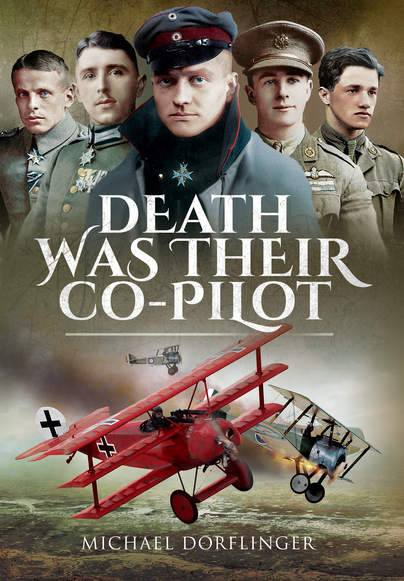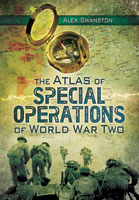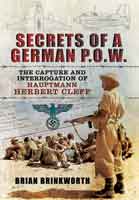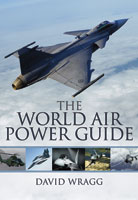Death Was Their Co-Pilot (Hardback)
Aces of the Skies
Imprint: Pen & Sword Aviation
Pages: 208
ISBN: 9781473859289
Published: 30th January 2017
(click here for international delivery rates)
Order within the next 3 hours, 37 minutes to get your order processed the next working day!
Need a currency converter? Check XE.com for live rates
| Other formats available - Buy the Hardback and get the eBook for free! | Price |
|---|---|
| Death Was Their Co-Pilot ePub (24.7 MB) Add to Basket | £6.99 |
It was in World War I that the skies first became a battlefield, with nations seeking to decide military outcomes off the ground. This volume introduces the fighter pilots of World War I, including the infamous “Red Baron” Manfred von Richthofen. In addition to this iconic flying ace, the author presents the thrilling biographies of numerous others and recounts their exploits and the tragedies they suffered. Likewise, the book illustrates the Great War’s historical background and documents the increasing sophistication of aviation technology and warfare.
For anyone wanting an accessible and slightly gossipy guide to the great aces of the First World War, this volume is as good a place as any to start and Dörflinger’s way of illustrating the peccadillos of these extraordinary men certainly livened up some of the stories I had read before.
Jill Bush Writes
Read the full review here
This book does its job well enough, providing brief biographies of the principal aces of the war plus a basic overview of the development of air fighting, the principal types of aeroplane used and the air services of the countries involved.
The Aviation Historian, issue 21
This is an unusual book, giving sometimes surprising insights into those violent and heroic days.
Society of the Fleet Air Arm Museum
Dorflinger's work introduces the reader to a number of these aces from both sides of the war. Their exploits, triumphs, and tragedies are all recounted in detail.
Military Heritage, November 2017
Engaging and informative. 10/10
The Great War magazine, July 2017 - reviewed by Mark Marsay
NOTE: reviewed alongside Fallen Eagles by Norman Franks
Ulster Airmail magazine – reviewed by Guy Warner
I was drawn to read these books as I have had an abiding interest in the aviators of the Great War ever since my father used to tell me bedtime stories (more than 50 years ago) of Ball, Mannock, Bishop and McCudden. I thought that a book from a German author, previously unknown to me, might give me an interesting new perspective. By contrast, Norman Franks is very well-known as one of the world’s leading authorities on the subject and any book he writes is highly likely to be well-researched and authoritative. I also thought that his chosen subject was an intriguing idea, consisting as it does, of more than 90 brief biographies.
There is no doubt that Michael Dörflinger has a deep interest in the airmen of the First World War, particularly those from the Central Powers (Imperial Germany and Austria), as opposed to what he calls the Entente Powers (Britain, France, Russia, Belgium, Italy and the USA). He has amassed a considerable amount of biographical information. He includes many photos which I had not seen before – particularly those depicting German airmen. However, the book is hampered by the author’s writing style, which lacks fluency and tends to jump about from place to place. I do not think that this is the effect of being translated from the original German. I believe that it would have been much better had the script been more tightly edited and revised, as in its present form it reads to me like a collection of notes which have been assembled rather than a fully developed and coherent account. The author makes many assertions and statements but does not follow them up satisfactorily, and some are simply wrong. On page 93, ‘In 1928 he [Willy Coppens] broke the world record for parachuting.’ I am really not sure what this means. Page 100, ‘Rickenbacker came from a region the US Army traditionally found many recruits.’ Even if true I do not really see the relevance. Page 105, ‘Jack Morris Wright wrote…’. We only find out much later who he was. Page 110 the photo caption is incorrect. Page xx we are told Gitterschwanz is contemporary German slang for aircraft with an open framework of metal tubes behind the cockpit [eg DH2, FE2B] but on page 144 two BE2 are said to be Gitterschwanz. Page 160 Billy Mitchell was not ‘reduced to the ranks’. Page 179 ‘the BF two seater was a very dangerous customer’ [Bristol Fighter?] appears in another paragraph on Gitterschwanz. Page 182 the DH4 did not have a 400 hp engine, the DH9a did. Page 184 the photo is of the SE5a and not a Sopwith Camel as captioned.
The overall effect is of a series of sketches loosely collated and put more or less in order. It is not an easy read. It also lacks an index and references to nearly all the many quotes in the text. The book is not without some interest but in my opinion is not up to Pen & Sword’s usual very high standards.
By complete contrast Norman Frank’s book is a gem and a worthy tribute to a host of previously unheralded pioneer air-fighters, only 11 of whom I had ever heard of before. He too has assembled a vast amount of information but puts it into a highly readable and informative shape. The reader is made aware of the full scope and inherent danger of aerial operations in the Great War by copious use of contemporary material – letters, citations, COs’ recommendations – but chiefly by the judicious use of the fund of knowledge which the author has gathered over a lifetime’s study. His attention to detail in such short essays is outstanding and the reader will glean much knowledge not only of the chosen airmen’s lives but also of many aspects of the war in the air and post-war aviation.
As I was reading the book I conducted a little statistical analysis which may be of interest. Unsurprisingly most of the aviators were born in England but others came from Australia, Canada, Ceylon, China, Cyprus, Ireland, the Isle of Man, Italy, New Zealand, modern day Pakistan, Scotland, South Africa, the USA, Wales and the West Indies. Most died in flying accidents, with only a few due to structural failure. Aerobatics, mid-air collision and take-off incidents accounted for many. Landing was much safer apparently. Six were lost at sea and one in the desert, while another was struck by lightning. Only four perished owing to hostile fire from the ground and one was unfortunate enough to be bombed by his own side while flying below.
I have only one very minor quibble, in his acknowledgements the author thanks those who are no longer with us for help with photographs – Jeff Jefford will be surprised by this, unless he is sending me e-mails from a much higher altitude than I thought.
This is an excellent addition to the bookshelf of any World War One enthusiast or historians, fit to rank alongside his definitive Above the Trenches series.
The book is filled with so many stories of heroism and patriotism, it is hard to pick the best examples. So many on each side returned to the fray in physical and mental conditions that should have kept them in a hospital bed, and not a cockpit.
A Wargamers Needful things
The other fronts besides the Western are touched on, as is the evolution of both armaments and the actual planes themselves. If you are looking for a book that shows the facts and figures, but also goes deep beyond them, then this book is for you.
Read the full review here.
This collection of biographies of WWI fighter pilots makes for compelling reading. This is a collection of portraits of men who are now as much myth and legend as history. A totally absorbing story that should not be missed.
Firetrench
Read the full review here.
The narrative provides wide and harrowing descriptions of the action, experience and confrontation these men experienced while in the air. One such description tells us that the 'airspace of the hunt swarmed with red, white and blue rounders which were all fighter aircraft. It required a tremendous amount of energy to keep the upper hand, especially since our aircraft were forced continually to intercept from below and prevent them breaking through to the artillery and infantry flyers'.
Jon Sandison, Freelance
The book is compliment by striking photographs and is an outstanding tribute and testimony to these brave men, who should not be forgotten. They are all very poignant. One of the most striking is that of Albert Ball standing with aeroplane propeller. He who was one of the few fighter pilots who became a British folk hero. He received the Victoria Cross posthumously. The author states that in Britain he was considered the fighter pilot without equal. Given the courage that all of these men displayed as made to lucid in this book, this is quite a powerful tribute.















